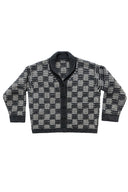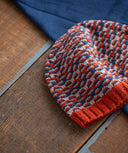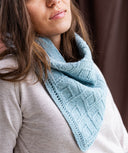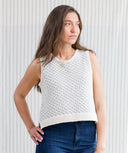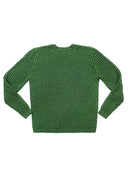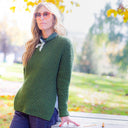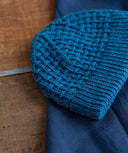How To Knit: Colorwork in Double Knitting
Double knitting is a unique technique that allows you to create a reversible, double-layered piece of fabric. When you work colorwork using this technique, it creates a color-reversed version of the same image on both sides. Since it does not require floats, double knitting is a great way to work patterns that have large stretches of a single color.
Written Steps
Double knitting requires you to have twice as many stitches as you need for your fabric width on your needle, because you are working two layers. Especially when working colorwork, two-color double knitting stitches can be treated in pairs - one stitch on the front layer knit in one color, and the corresponding stitch on the back layer purled in the other. When working from a chart for double knit colorwork, each square represents one of those pairs of stitches.
How to double knit in two colors:
The basics of working double stockinette consist of knitting the first stitch of each pair with both of your yarns in the back, bringing the yarns to the front of the work, purling the second stitch of the pair, then bringing the yarns to the back. Keeping the unused yarn to the opposite side of the work from the stitch being worked creates a double-sided stockinette fabric with no true wrong side. To make things easier to maneuver, regardless of whether you knit English style or Continental, you’ll want to hold both of your yarns in one hand so that the color you’re working knit stitches with is toward the front, and the color you’re purling with is toward the back. That way, whether the yarns are in the front or the back, you’ve got the color you need closest to the needles in position to use. It’s also worth noting that since there are no floats in double knitting, color dominance is not a factor in terms of how you hold your yarns, so tension them the way that is comfortable for you - a knitting thimble can be helpful here if you are a Continental knitter.
Using a chart:
Even though this fabric is reversible, there will still be an established “right side” to keep things straight, and on that side the charted stitches will represent the color we’ll use to knit (Color 1), and we’ll purl the other stitch in each pair with our second color (Color 2). So we’ll start by knitting the first stitch on the left needle in Color 1, bringing our yarns to the front, purling the second stitch in the other color, Color 2, then bringing both yarns back to the back. That’s taken care of the first stitch box on the chart, since each charted stitch represents a pair of stitches on your needle. We’ll keep on doing this until we reach a stitch that’s charted in Color 2.
When we reach a color change, we’ll want to switch the orientation of the yarns so that Color 2 is toward the front and Color 1 is toward the back. This will involve crossing your yarns over each other, but don’t worry because we can correct that when we switch back. Then we can knit the next stitch in Color 2, bring both yarns to the back, purl the following stitch in Color 1, and bring both yarns to the back. We’ll work all the Color 2 stitches on the chart this way, then when we get to more Color 1 stitches we’ll switch the orientation of the yarns back and knit in Color 1 and purl in Color 2, making sure to cross the yarns back over each other in the reverse of the way you crossed them before to keep your yarns from tangling.
Tracking your work:
This style of knitting is often used to make shapes on fabric, using one color for the shape and the other color for the background. One way to make the knitting process easier is to visualize the shape you're making and follow how the outline of that shape is changing on the chart and base when to switch from Color 1 to Color 2 by those changes, and spot check against the chart as you go. You can also add grid lines to the chart in regular intervals, like every 5 stitches, if your chart doesn’t already have them to make it easier to track your work.
Tips for working flat or in the round:
Double knit colorwork can be worked flat or in the round, but if you’re working flat you’ll need to make sure that you twist your yarns together at the beginning or end of each row to keep the layers together, and switch which colors you’re knitting and purling with based on the chart on every other row to keep the design consistent as a reverse image. This means that on even-numbered chart rows, I would read the charted stitches in Color 1 as knitting in Color 2 and purling in Color 1, and vice versa, reading the chart from left to right. When working in the round, all chart rows would be read from the chart as-is, right to left.
